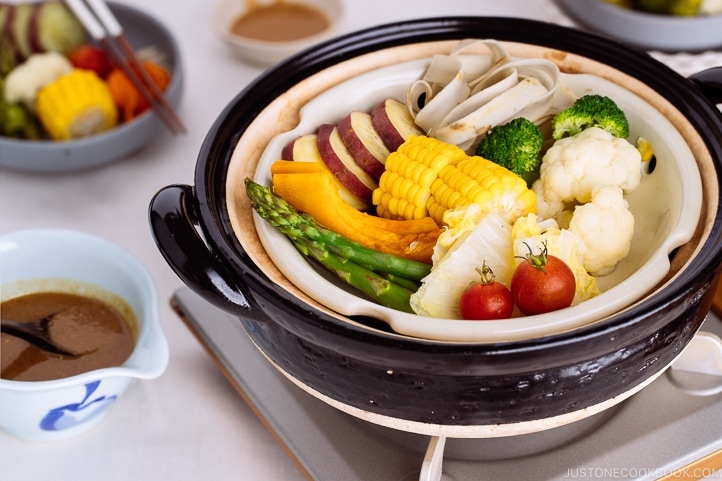
Healthy and full of flavor, this dashi-infused Steamed Vegetables with Miso Sesame Sauce is the quickest way to get vegetables on your plates. Served with an umami-packed dipping sauce, you will want to eat another serving!
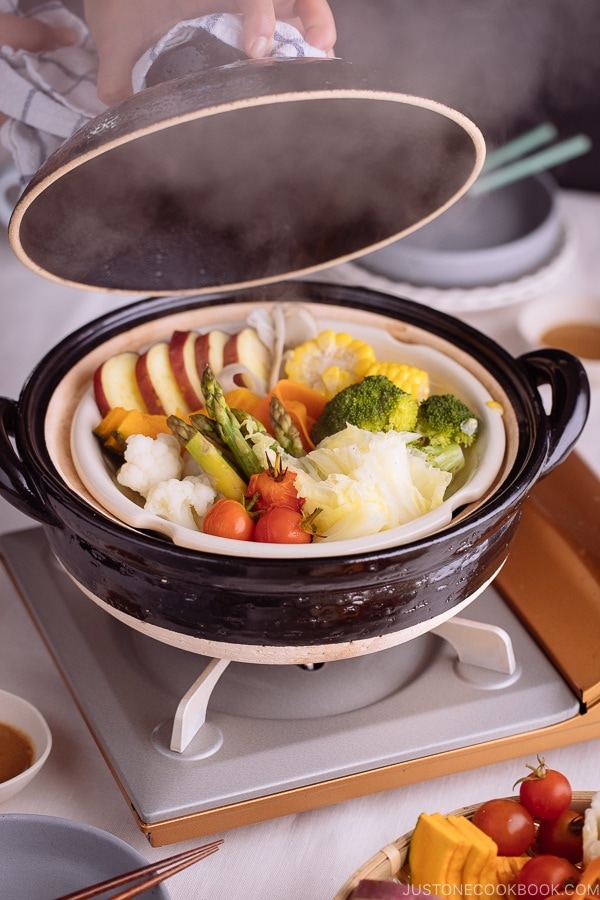
How do you eat your vegetables every day? Do you eat it as a salad, stir fry, roasted or steamed, or try to avoid it altogether? Today’s recipe will convince you to eat more of them. You’ll learn how to steam vegetables correctly and whisk together the most delicious miso sesame sauce that makes everything taste even better.
The prep requires little effort that you can steam the veggies while you’re working on other dishes. Sounds great for a weeknight meal, isn’t it? Let’s get started.
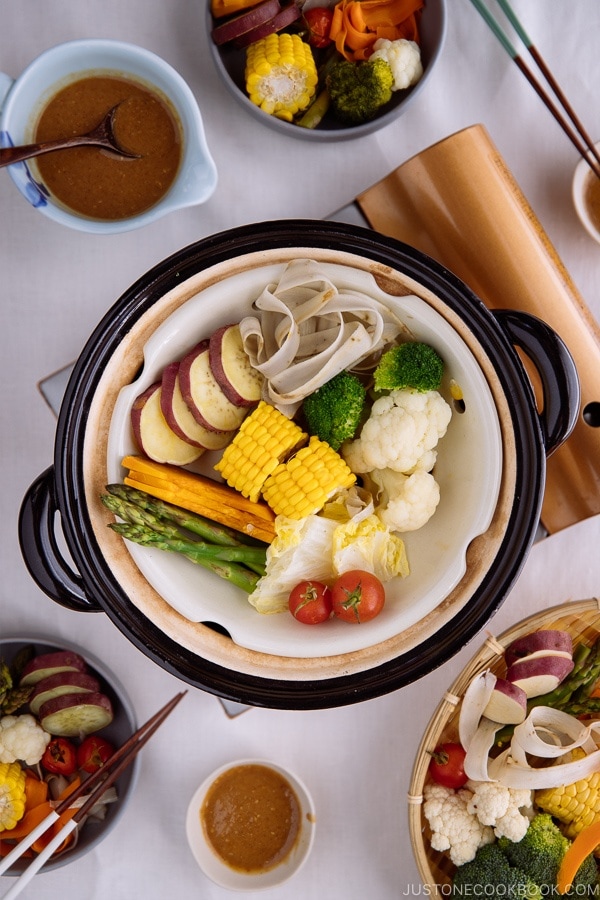
How to Steam Vegetables Perfectly Everytime
Steaming vegetables is one of the best ways to cook vegetables as steam cooking helps to preserve all the important nutrients and fiber of the vegetables. However, they can be easily overcooked. When the vegetables are over-cooked and mushy, they lose their texture and colors which can be unappetizing.
How do we avoid that? I’m here to guide you on how to perfectly steam any vegetable in a few easy steps.
1. Steam vegetables in stages based on their texture
Texturally speaking, we can group the vegetables into two types: tender vs hard. The harder and denser vegetables require a longer cooking time, while tender vegetables cook a lot of faster, so it’s always important to cook them at stages. When you’re steaming vegetables, start with root vegetables such as sweet potato and carrot first, and after several minutes, you can add in tender vegetables like broccoli and zucchini into the basket.
2. Cut vegetables into uniform sizes
Each vegetable, whether hard or tender, requires the same amount of time to steam. To achieve the perfect crisp-tender texture, you need to cut them into uniform sizes so they cook roughly at the same rate.
One trick to shorten the overall steaming time is to cut the hard vegetables slightly smaller or thinner so that they cook faster.
3. Stop steaming slightly earlier
I also like to take vegetables out of the steamer when they are still a little bit crunchy. The residual heat will cook the vegetables slightly more so you don’t have to steam the vegetables until completely done. By the time you sit at the table, they might be gone mushy.
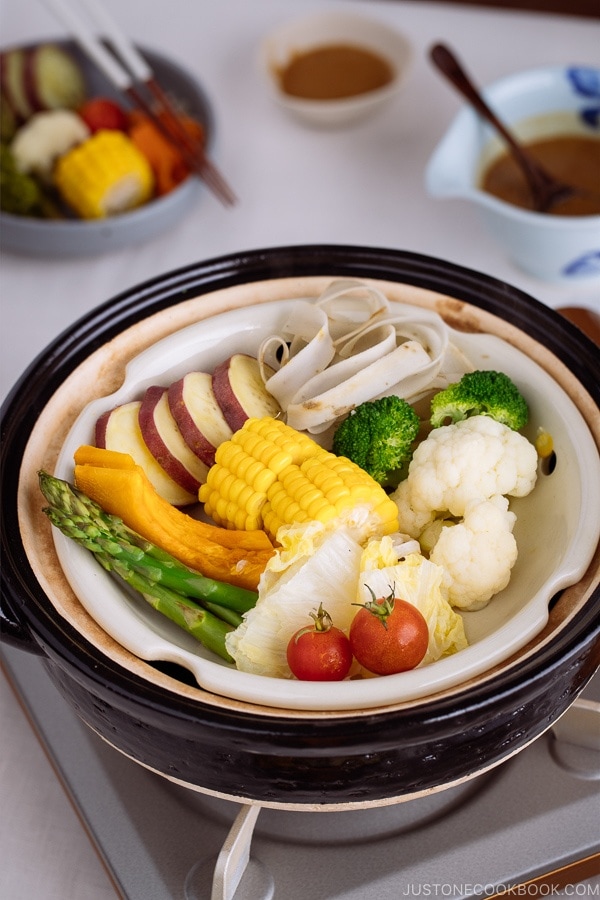
How Long to Steam Vegetables
Here’s a quick guide on steaming times for vegetables.
- Asparagus: 5-8 minutes
- Broccoli: 3-5 minutes (florets) 7 minutes (stems)
- Cabbage: 3-5 minutes
- Carrots: 8-13 minutes
- Corn on cob (1-2 inches): 8-10 minutes
- Cauliflower: 3-5 minutes (florets), 7 minutes (stem)
- Gobo slices: 5-10 minutes
- Green beans: 4-6 minutes
- Kabocha: 10-15 minutes
- Potatoes: 10-15 minutes
- Spinach: 2-3 minutes
- Sweet potatoes: 10-15 minutes
- Zucchini: 5-8 minutes
If you want to cook several kinds of vegetables in a batch, here’s an easier method that I follow:
- Leafy veggies: 2-3 minutes
- Mushrooms: 3-5 minutes
- “Fruit” vegetables (corn, cucumber, eggplant, pumpkin, zucchini, etc): 5-8 minutes
- Root vegetables: 8-10 minutes
- Potatoes and sweet potatoes: 10-15 minutes.
I usually adjust the steaming time based on how I cut the vegetables (slices vs. peels – see my recipe for gobo and carrot) and how big/small I cut them.
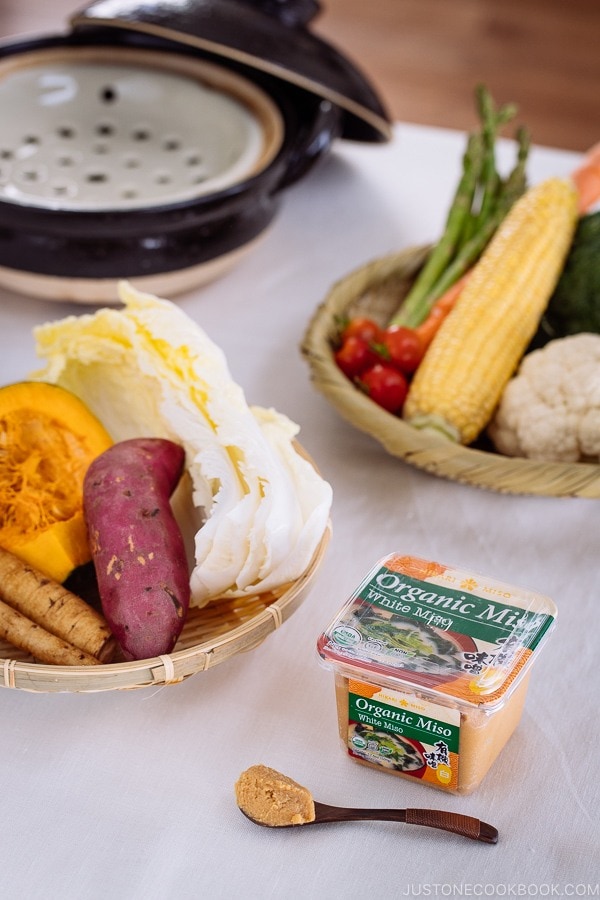
Make Miso Sesame Sauce for Steamed Vegetables
Steamed vegetables are absolutely wonderful on its own or with very little seasoning. However, I do like to serve steamed vegetables with different Japanese-style dipping sauces once in a while, and one of our favorites is Miso Sesame Sauce.
For this Steamed Vegetables recipe, I partner with Hikari Miso® and used Hikari Miso® Organic Miso – White Miso. It is made of 100% USDA Certified Organic rice and soybeans and is additive-free. It has a light yellow color original to Shinshu-style miso. A high volume of rice koji produces its mild taste and smooth texture.
If you’re interested to try it out, you can purchase Hikari Miso from a majority of Japanese/Asian grocery stores or on Amazon. It is my favorite brand of miso paste. There is also a variety of miso, each with a different flavor you can use for various purposes.
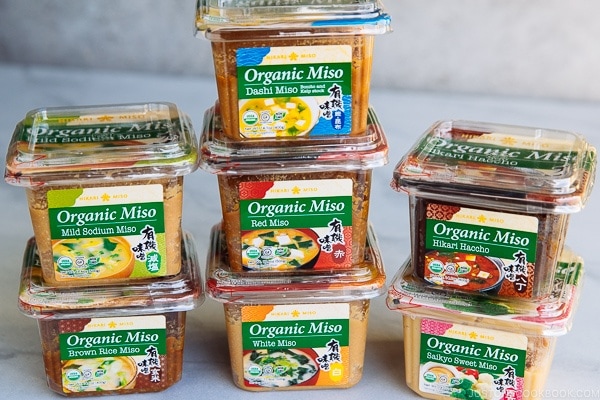
The nutty flavor and savoriness of the sauce go terrifically well with vegetables. The key is to lightly dip the steamed vegetables into the sauce, without overcoating them. You want to enjoy the natural sweetness of the vegetables and the sauce is to enhance the eating pleasure.
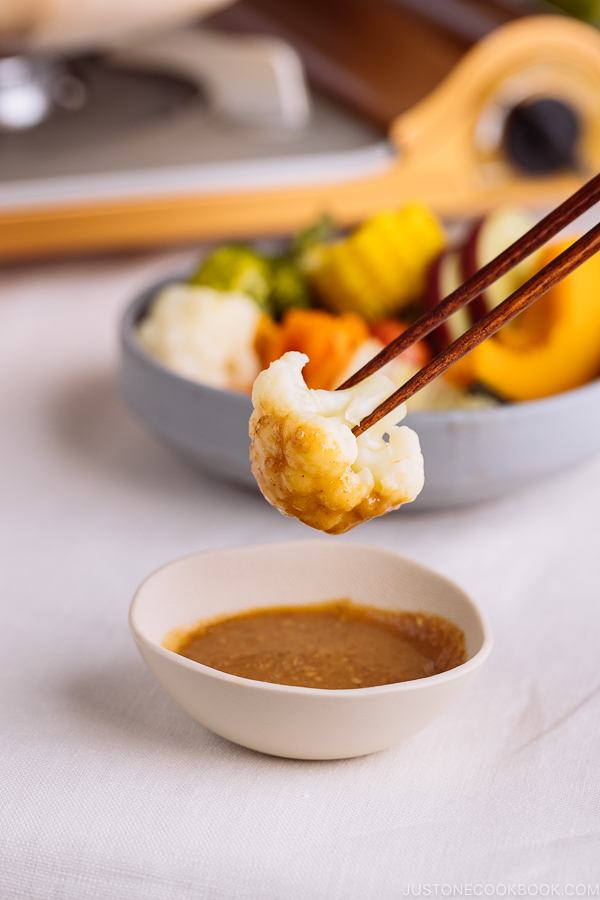
Additional Tips to Make Perfectly Steamed Vegetables
1. Use a large pot with the lid
It’s always better to use a bigger pot where steam can go around the vegetables.
2. Add 1-2 cups water
You’ll need at least 1 inch deep of water, just enough to steam the vegetables. You can use the leftover water for cooking. In fact, we use dashi – Japanese stock – to create dashi-infused steam to cook the vegetables in this recipe.
3. Add vegetables after boiling
It’s important to add the vegetables after the water is completely boiling. If you add the vegetables while the water has yet to boil, the newly created steam will turn back into water droplets when it touches cold vegetables. As a result, vegetables will get more watery. Therefore, add the vegetables when there is plenty of steam coming out from the steamer.
4. Keep on medium high heat
You want to make sure lots of steam is continuously being created, and your heat setting should be on medium-high. When you add the vegetables, the temperature will drop quickly, so keep the heat on high for 2-3 minutes first.
5. Use a bamboo skewer to check doneness
Don’t rely on the cooking time so much. Even with the same vegetables, steaming time can be different based on how you cut the vegetables. The best way is to use a bamboo skewer and see if it goes through.
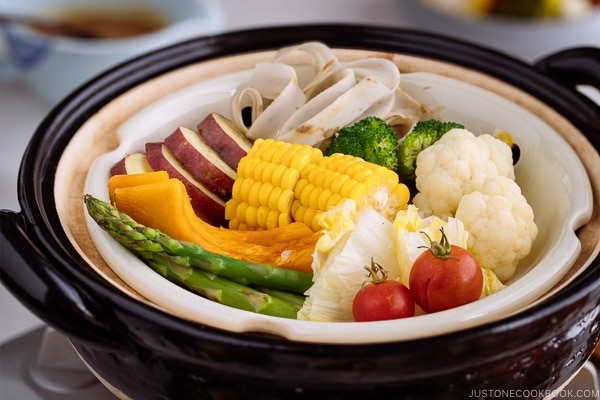
How to Steam Vegetables without a Steamer
The most common way to steam vegetables is by using a pot with a good fitting lid and a metal steamer basket. What if you don’t have a steamer? Don’t worry! You can still enjoy this steamed vegetable recipe without it. Here’s a fantastic hack I learned from a friend:

Make three tennis-size balls with aluminum foil and place them on the bottom of your cast iron pot.
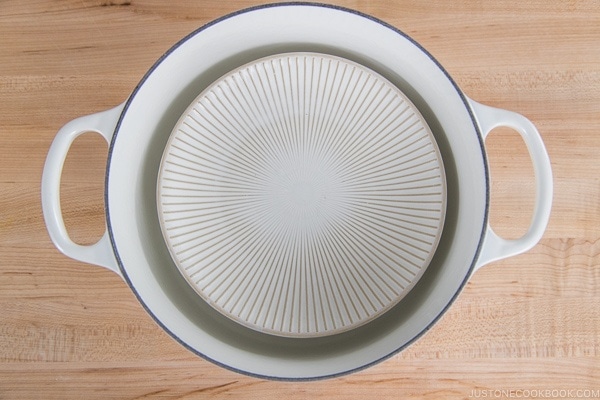
Add 1-2 inches of water and place a ceramic plate on top of the tinfoil balls!
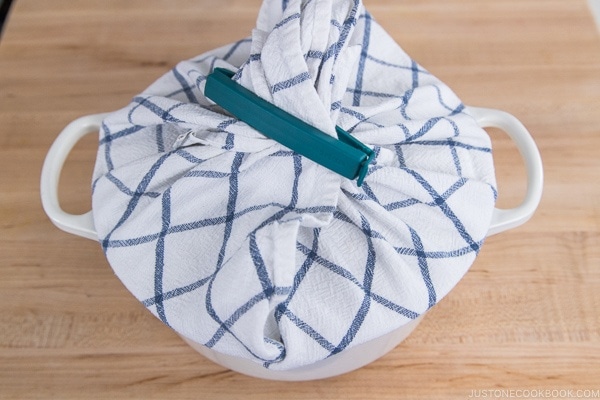
This is not from my friend’s method, but if your lid is flat, cover it with a large kitchen towel so condensation won’t drop on the food and make it watery.
My Donabe Steamer
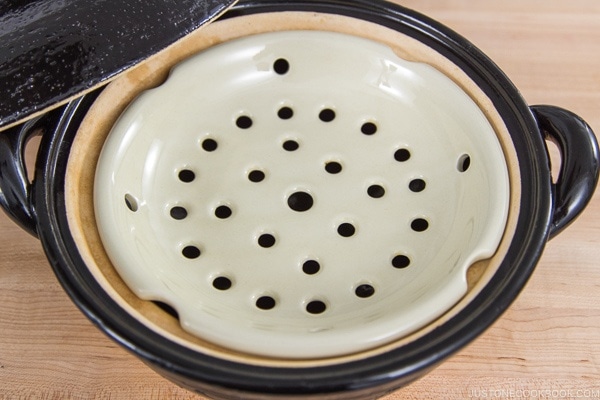
I purchased this donabe steamer at Toiro Kitchen & Supply in Los Angeles. The owner Naomi-san has a beautiful online shop where they ship worldwide.
Steamed vegetables are great all year around, but it’s more fun to serve at a table with a portable stovetop especially in fall and winter time. Colorful, bright and extremely nutritious, they are what good eating is about. And don’t forget to enjoy the vegetables with the lip-smacking miso sesame sauce!
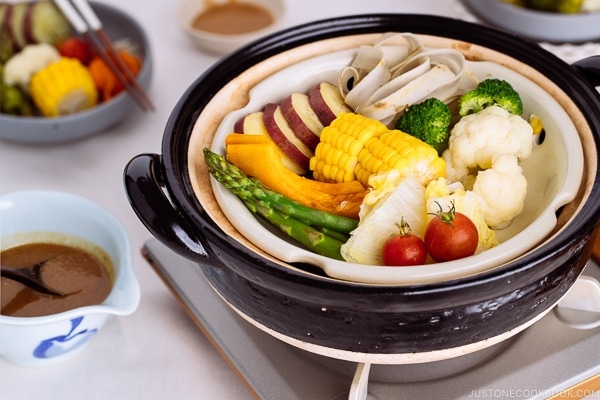
Don’t want to miss a recipe? Sign up for the FREE Just One Cookbook newsletter delivered to your inbox! And stay in touch on Facebook, Google+, Pinterest, and Instagram for all the latest updates.
Steamed Vegetables with Miso Sesame Sauce
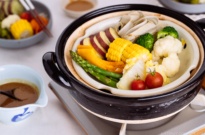
Healthy and full of flavor, this dashi-infused Steamed Vegetables with Miso Sesame Sauce is the quickest way to get vegetables on your plates.
- 2 cups dashi ((I used Awase Dashi, but use Kombu Dashi for vegan/vegetarian – See Notes) (or water))
Vegetables for Steaming
- 1 Japanese sweet potato
- ½ gobo (burdock root)
- ¼ kabocha squash
- 1 carrot
- 1 ear fresh corn
- 10 asparagus
- 1 head broccoli
- 1 head cauliflower
- 5 leaves napa cabbage
- 10 cherry tomatoes
Miso Sesame Sauce
- 6 Tbsp white sesame seeds (roasted/toasted)
- 2 cloves garlic
- 1 tsp sugar
- 2 Tbsp miso
- 2 Tbsp soy sauce
- 2 Tbsp sesame oil
- 4 Tbsp mirin
- 2 Tbsp rice vinegar
- ¼ tsp kosher salt
To Prepare the Miso Sesame Sauce
- Gather all the ingredients for Miso Sesame Sauce.
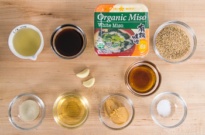
-
Grind 6 Tbsp sesame seeds.
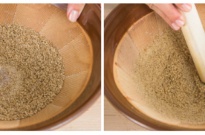
- Crush 2 cloves garlic. Add 1 tsp sugar and 2 Tbsp miso and combine well.
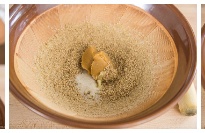
-
Add 2 Tbsp soy sauce, 2 Tbsp sesame oil, 4 Tbsp mirin, and 2 Tbsp rice vinegar. Mix well.
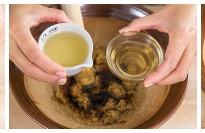
-
Check the taste and add kosher salt if necessary. I added ¼ tsp salt.
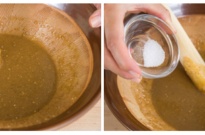
To Prepare the Vegetables
- Prepare all the ingredients. Make dashi; otherwise, use water instead.

- Cut the sweet potatoes into ¼ inch slices (uniform smaller pieces will cook faster than larger pieces) and soak in water to remove starch. Drain and set aside.
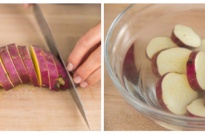
-
Wash the gobo really well and peel it thinly with a peeler. Soak in water immediately to avoid color changes and change the water once. Drain and set aside.

- Discard the seeds from kabocha and slice thinly.
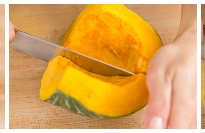
- You can either cut the carrot into ¼ inch slices or use a peeler to peel the carrot.
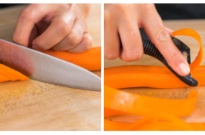
- Cut the corn on the cob into 1-inch thickness.
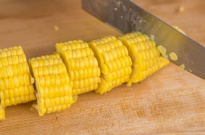
-
Hold each asparagus, snap and discard the shorter bottom end. Cut the asparagus in half.
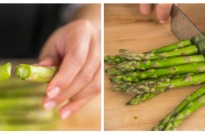
- Cut the broccoli and cauliflower into florets.
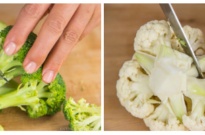
- Cut the napa cabbage into bite-size pieces.
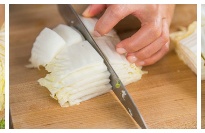
To Steam
- Pour the dashi in your steamer, cover the lid, and bring it to boil on medium-high heat. As a quick guide, dashi (or water) should be at least 1-2 inches to your steamer (pot). Insert the steamer basket. Make sure the surface of the dashi (or water) is not touching the basket. If it is, take out some water.
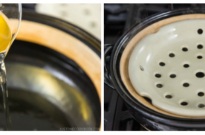
- When steam is coming out from the pot strongly, reduce the heat to medium and place the hard vegetables such as sweet potatoes and root vegetables. I also added kabocha squash and corn here as the rest of ingredients are fairly fast to cook. Cover the pot and set timer for 5 minutes.
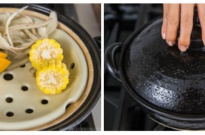
- Then add “Flower” vegetables such as asparagus, broccoli, cauliflower, and the bottom part of the napa cabbage. I also added carrot peels here. Set the timer for 3 minutes.
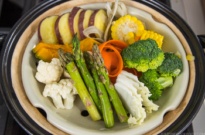
-
Lastly, add the leafy part of the napa cabbage and mini tomatoes. Cook for 2 more minutes.
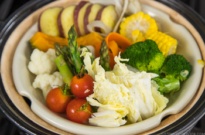
-
Insert a bamboo skewer to check the doneness of denser vegetables. If it goes through, it’s ready to eat! Stop the steaming when the vegetables are still a bit crunchy since the residual heat will continue to cook the vegetables.

- Serve the steamed vegetables with Miso Sesame Sauce and enjoy! During the meal, you can continue to steam the vegetables. Keep an eye on the dashi/water inside the pot. Make sure you are not running out of dashi/water. If it’s too little, add more dashi/water.

Dashi: Awase Dashi (regular dashi) or vegan/vegetarian friendly Kombu Dashi.
Recipe by Namiko Chen of Just One Cookbook. All images and content on this site are copyright protected. Please do not use my images without my permission. If you’d like to share this recipe on your site, please re-write the recipe in your own words and link to this post as the original source. Thank you.